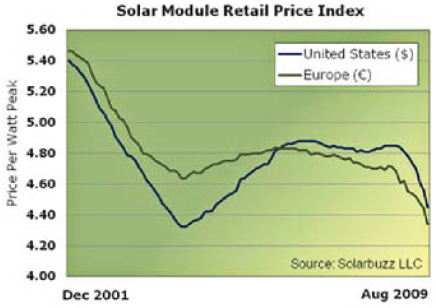Solar powered pumps
| |
The climate in many countries in the developing world is suitable for solar pumping. Solar energy is a valid option for small-scale water pumping in rural areas where the demand is regular, such as for drinking water, but it may also be used for irrigation. Applications of solar systems are growing at steady rate.
Photovoltaics (PV) is a technology that converts sunlight directly into electricity. It was discovered in 1839 by the French scientist Antoine Henri Becquerel. About 50 years ago, the space programmes provided an incentive for the development of crystalline silicon solar cells. The production of PV modules began.
With the global drive to reduce carbon dioxide emissions, PV technology is increasingly used as a mainstream form of electricity generation. Many thousands of systems are presently in use and the vast potential for PV as an energy source has not yet been utilized.
PV modules provide an independent, reliable electrical power source at the point of use, making them particularly suited to remote locations. PV systems are technically viable and with more commercial applications the technology is developing fast and prices are coming down, making PV more and more economically feasible for rural water supplies.
Suitable conditions
With solar water systems the water is pumped during the peak sunshine hours of the day. It can be stored in a tank, and therefore it is not necessary to use batteries. The storage tank can be sized to provide some reserve during cloudy or rainy days. In sub-Saharan Africa the typical storage is about 3 to 5 days of water demand. In environments where rainy seasons occur, rainwater harvesting can offset the reduced output of the solar pump during this period.
Construction, operations and maintenance
Solar panels are a very reliable piece of equipment and many manufacturers sell the panels with a guarantee of 25 years. It should be noted that such a warranty can only be honoured if the supplier is still in business in 25 years. Therefore, it is advisable to select reliable suppliers rather than to choose the cheapest source.
Solar PV modules are normally specified by Watt-peak. Wattpeak or Wp is the measure of power output of photovoltaic solar energy. They are very costly pieces of equipment. A 50 Wp module costs several hundred dollars and has a good resale value in many countries. Theft is already a problem in some areas.
There are three main types of cells on the market: monocrystalline silicon, multi-crystalline silicon, and amorphous silicon. New, non-silicon types such as cadmium telluride (CdTe) and copper indium disellenide (CIS) have recently become available.
Costs
The prices of PV modules have fluctuated a lot over the last decade, but in 2009 there was a sharp fall in prices. These developments are influenced by raw material prices and the market situation. Below, the chart shows the changes in price from 2001 to 2009. It is advisable to check for up-to-date price information at solarbuzz.com.



